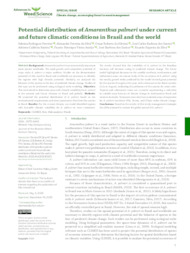Potential distribution of Amaranthus palmeri under current and future climatic conditions in Brasil and the world.
Potential distribution of Amaranthus palmeri under current and future climatic conditions in Brasil and the world.
Author(s): FERREIRA, S. R.; SILVA, A. F. da; SILVEIRA, O. R. da; SANTO, J. C. B. dos; BATISTA, A. C.; ARAUJO, F. H. V.; SANTOS, J. B. dos; SILVA, R. S. da
Summary: BACKGROUND-Amaranthus palmeri is an economically important plant species worldwide. The rapid growth and competitive potential of crops make A. palmeri a major problem. Studies on the dissemination potential of this weed in Brazil and worldwide are necessary to identify the regions with high climatic potential. Similarly, we analyzed the behavior of the species in the face of predicted climate change. Studies of this type can be performed using ecological niche modeling. OBJECTIVE- this work aimed to determine areas with climatic suitability for A. palmeri in the present and future climates in Brazil and globally. METHODS-We projected the potential distribution of A. palmeri based on the environmental requirements and stress parameters that limit this species in Brazil. RESULTS- For the current climate, our model identified regions with favorable climatic suitability for A. palmeri on most continents. The results showed that the suitability of A. palmeri in the Brazilian territory will decrease owing to predicted climate change. The future model highlighted decreases in the suitable northern, northeastern, and midwestern areas. An annual study of the occurrence of A. palmeri using the weekly growth index predicted by the model showed great potential for the species throughout the year, with a decrease in the driest months (July to August), indicating the preference of the species for moist soils. Tropical and subtropical zones are currently experiencing a reduction in suitable areas because of climate change in northeastern Brazil and western Australia. Temperate zone sites have potential areas of expansion for A. palmeri (northern USA, Russia, and China) under climate change. CONCLUSIONS- Based on the results of this study, management strategies should be planned to contain the global spread of A. palmeri.
Publication year: 2023
Types of publication: Journal article
Unit: Embrapa Maize & Sorghum
Observation
Some of Embrapa's publications are published as ePub files. To read them, use or download one of the following free software options to your computer or mobile device. Android: Google Play Books; IOS: iBooks; Windows and Linux: Calibre.
Access other publications
Access the Agricultural Research Database (BDPA) to consult Embrapa's full library collection and records.
Visit Embrapa Bookstore to purchase books and other publications sold by Embrapa.

